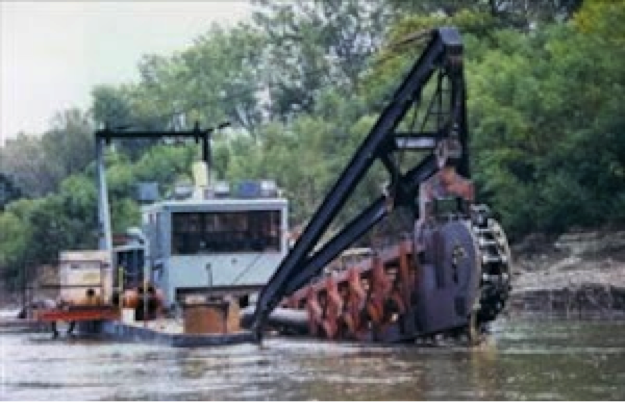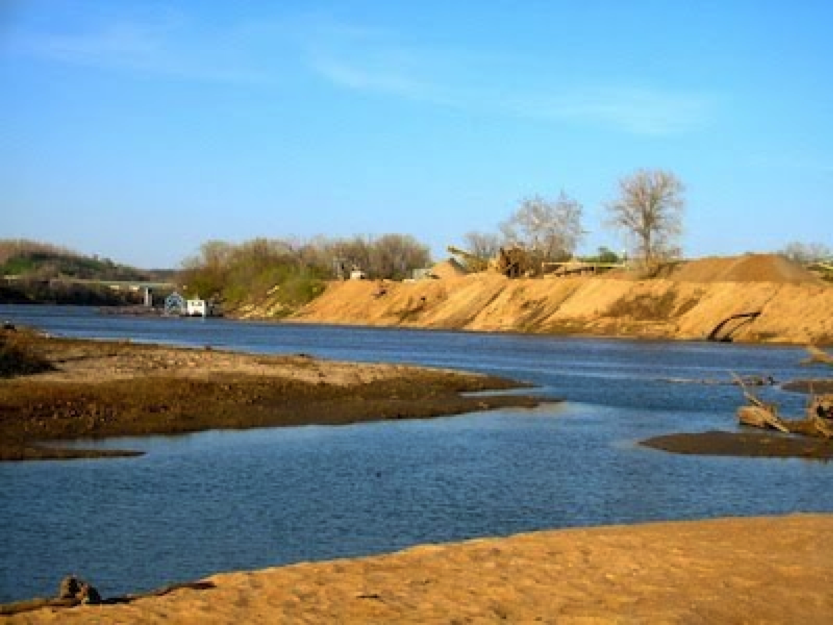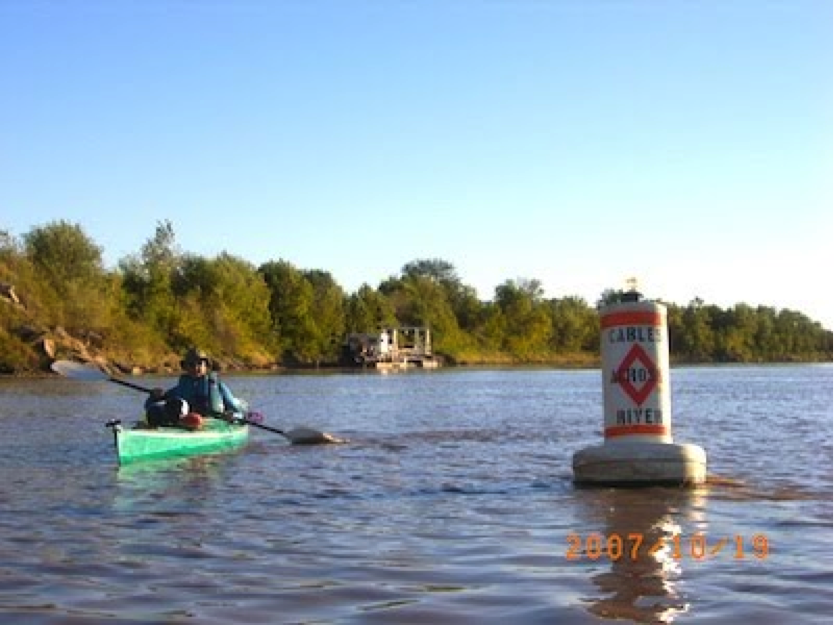The Kansas River has been commercially mined (dredged) for sand and gravel since the early 1900’s. Sand from the Kaw is highly sought after because of its size and shape, which make it particularly valuable to the concrete industry. Kansans have benefited from good quality roads and buildings thanks to the Kaw. In recent years, however, dredging activities have been documented through careful studies to have caused significant damage to the Kaw’s riverbed, to habitat in and along the river, and to water quality, resulting in the Corps closing stretches of the river to further dredging. Download Regulatory Report
River Bed Degradation
The Kaw is vulnerable to degradation from dredging because it is a single, connected system that naturally works to maintain balance. When dredging companies take sand and gravel out of the riverbed, the river fills the resulting hole with sand and silt removed from upstream. Before the completion of the 18 federal reservoirs in the Kansas River watershed, a much larger quantity of sand was naturally transported from tributaries to the main river, providing material to fill the holes made by sand dredges. Today the dams on the reservoirs block most of the movement of sand to the Kansas River from its tributaries, and the river is forced to remove sand to fill the holes from a much more limited area in the mainstem river. The two areas on the Kaw that have been dredged for many years, from the K-7 bridge to Kaw Point in Kansas City, KS and through the city of Topeka, are void of sandbars because of this displacement of sand.
Since the 1960’s “head cutting” has become more common as the river takes sand and dirt from the banks of the main river upstream from the dredging operation to fill the dredge holes. In some cases head cutting causes trees and vegetation (riparian forest) growing on banks to collapse into the river, in others it takes land from riverside property owners like farmers and ranchers.
 Bank erosion caused by head cutting is often stabilized by landowners with illegal materials like concrete rubble, tires, and old car bodies. The riparian forest is lost, along with all of the animals that depended on the trees, including nesting bald eagles. The roots of trees and bushes that had stabilized the banks and filtered polluted water from urban and agricultural runoff are also lost. If a bridge support, water intake, or other man-made structure is upstream from the dredge site, it may be damaged by erosion from head cutting. This kind of damage is very costly to repair, and repairs are usually paid for by our tax dollars.
Bank erosion caused by head cutting is often stabilized by landowners with illegal materials like concrete rubble, tires, and old car bodies. The riparian forest is lost, along with all of the animals that depended on the trees, including nesting bald eagles. The roots of trees and bushes that had stabilized the banks and filtered polluted water from urban and agricultural runoff are also lost. If a bridge support, water intake, or other man-made structure is upstream from the dredge site, it may be damaged by erosion from head cutting. This kind of damage is very costly to repair, and repairs are usually paid for by our tax dollars.
 When head cutting happens, the heavier sand particles settle out and fill the hole while the lighter dirt particles tend to stay suspended in the water. The mechanical activity of dredging adds to this by stirring up the sediments on the riverbed and re-suspending dirt particles.The dirt particles are carried downstream until they create a blanket of silt on the river bottom; this thick blanket of fine silt can suffocate aquatic live, especially mussels. Many harmful chemicals like PCBs and Atrazine tend to stick to dirt particles and are carried into the river by dirt eroding off the banks. Increased quantities of dirt particles, especially when contaminated, are more costly to remove from drinking water, resulting in higher costs to the public.
When head cutting happens, the heavier sand particles settle out and fill the hole while the lighter dirt particles tend to stay suspended in the water. The mechanical activity of dredging adds to this by stirring up the sediments on the riverbed and re-suspending dirt particles.The dirt particles are carried downstream until they create a blanket of silt on the river bottom; this thick blanket of fine silt can suffocate aquatic live, especially mussels. Many harmful chemicals like PCBs and Atrazine tend to stick to dirt particles and are carried into the river by dirt eroding off the banks. Increased quantities of dirt particles, especially when contaminated, are more costly to remove from drinking water, resulting in higher costs to the public.
Water Quality Degradation
In-river dredging operations also degrade water quality because they are allowed to directly return river water that is sucked up with the sand and gravel from the bottom of the river. Sand dredging operations discharge pollutants from pipes and ditches directly into the Kaw. The Kansas Department of Health and Environment (KDHE) does not require dredging companies to have National Pollution Discharge Elimination System (NPDES) permits for these point source pollution discharges nor do they require these operations to use regularly maintained settling ponds before these waters are discharged back to the Kaw.
Hazard to Boaters
Boaters should be cautious when paddling or motoring by a dredge, particularly if it is actively mining sand, because the cables that attach the dredge to the bank can be a hazard. Cables can be just under the surface of the water, above the surface of the water, or moving up and down near the surface of the water.
Improving Sand and Gravel Mining in the Kaw River Valley
Friends of the Kaw understands that sand is needed for a healthy construction economy but believes sand can be reasonably and efficiently obtained from pit mines in the Kansas River valley. Friends of the Kaw has actively promoted this philosophy for many years and, while some progress is being made, we have observed that locating a pit mine is not a quick or easy process. Finding the correct location and working with the local residents and government takes time and careful planning, but it can, and should be done.
In 2007 Holliday Sand and Gravel permitted a new pit mine in Shawnee, Kansas west of K-7 Highway adjacent to the Kansas River. This new pit mine will eventually replace their pit mine east of K-7 in the same area. The pit mine east of K-7 will be reclaimed and upon completion of the extraction of sand from the site, anticipated to be 2014, a 115 acre lake will be created. The property has been donated to the City of Bonner Springs and the City of Shawnee for future recreation space. Likewise the new pit mine located west of K-7 will be reclaimed and donated to the City of Shawnee for future recreation space. The permitting of the Shawnee pit mine by Holliday Sand and Gravel involved years of detailed planning, included specific reclamation requirements, and was done without rancorous public opposition. Mike Odell, Vice President of Operations for Holliday Sand and Gravel, said “Pleasing the local government goes a long way towards pleasing the community.”
Locating a pit mine does have implications that need to be carefully considered by the local community and government. Truck traffic to haul out-going sand and gravel needs to be carefully planned to minimize impact on community and infrastructure. A location with a short, direct access to a major highway is best. Using electric dredging equipment minimizes noise and the possibility of fuel spills. Negotiating a detailed reclamation plan with the local community or government prior to the permitting process is also recommended. Finally, pit mines must not be located near the river in locations that are prone to “river capture” during high water events. Friends of the Kaw is currently working on a set of siting guidelines to help communities and commercial dredgers avoid locating pit mines in environmentally sensitive locations that could adversely impact the Kaw.




 Paddle safely! Use the links below to quickly access information that impacts river conditions.
Paddle safely! Use the links below to quickly access information that impacts river conditions.
